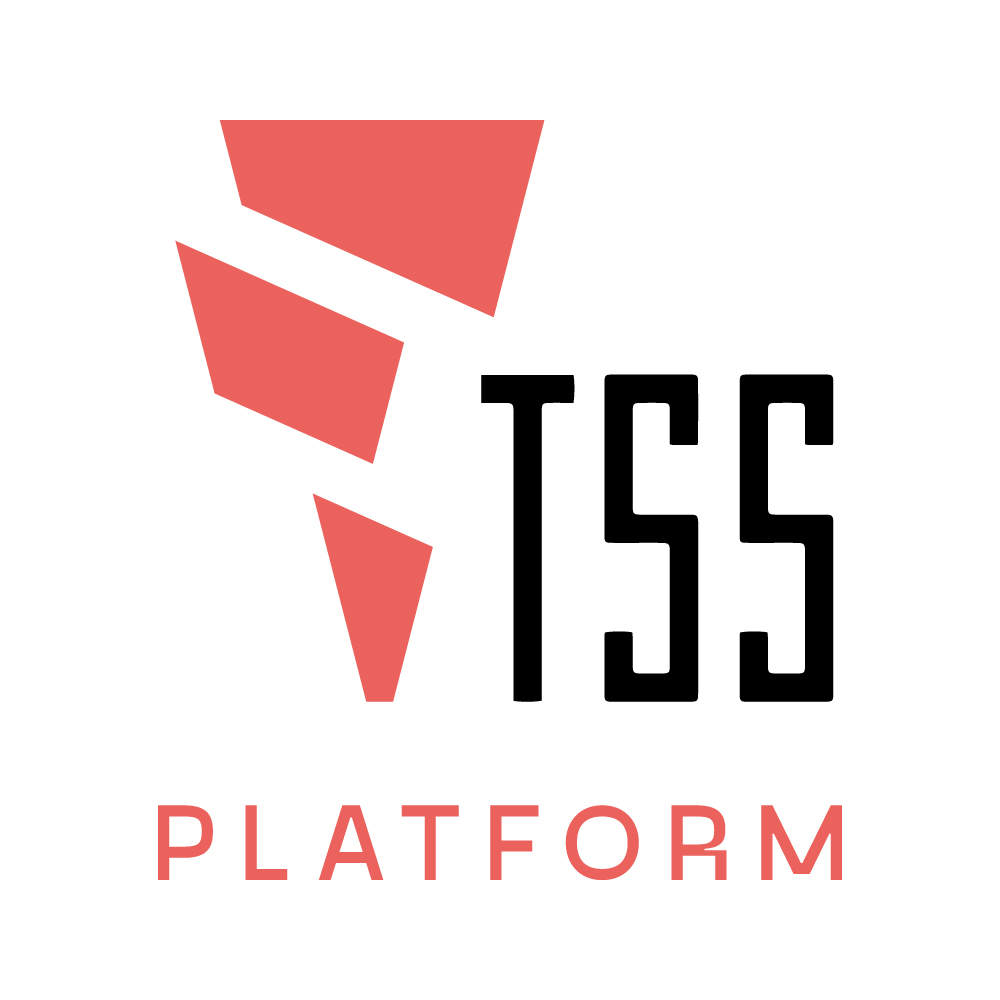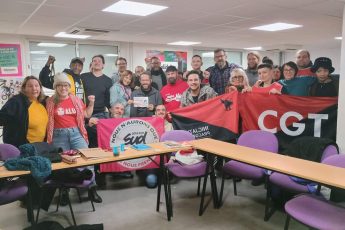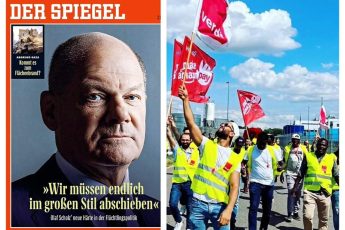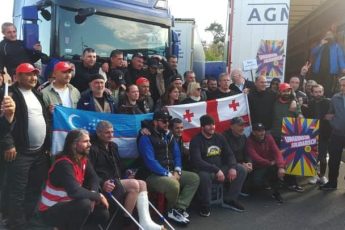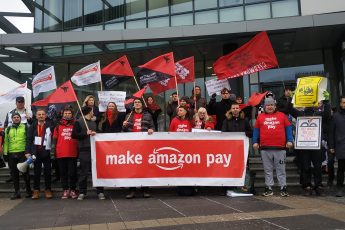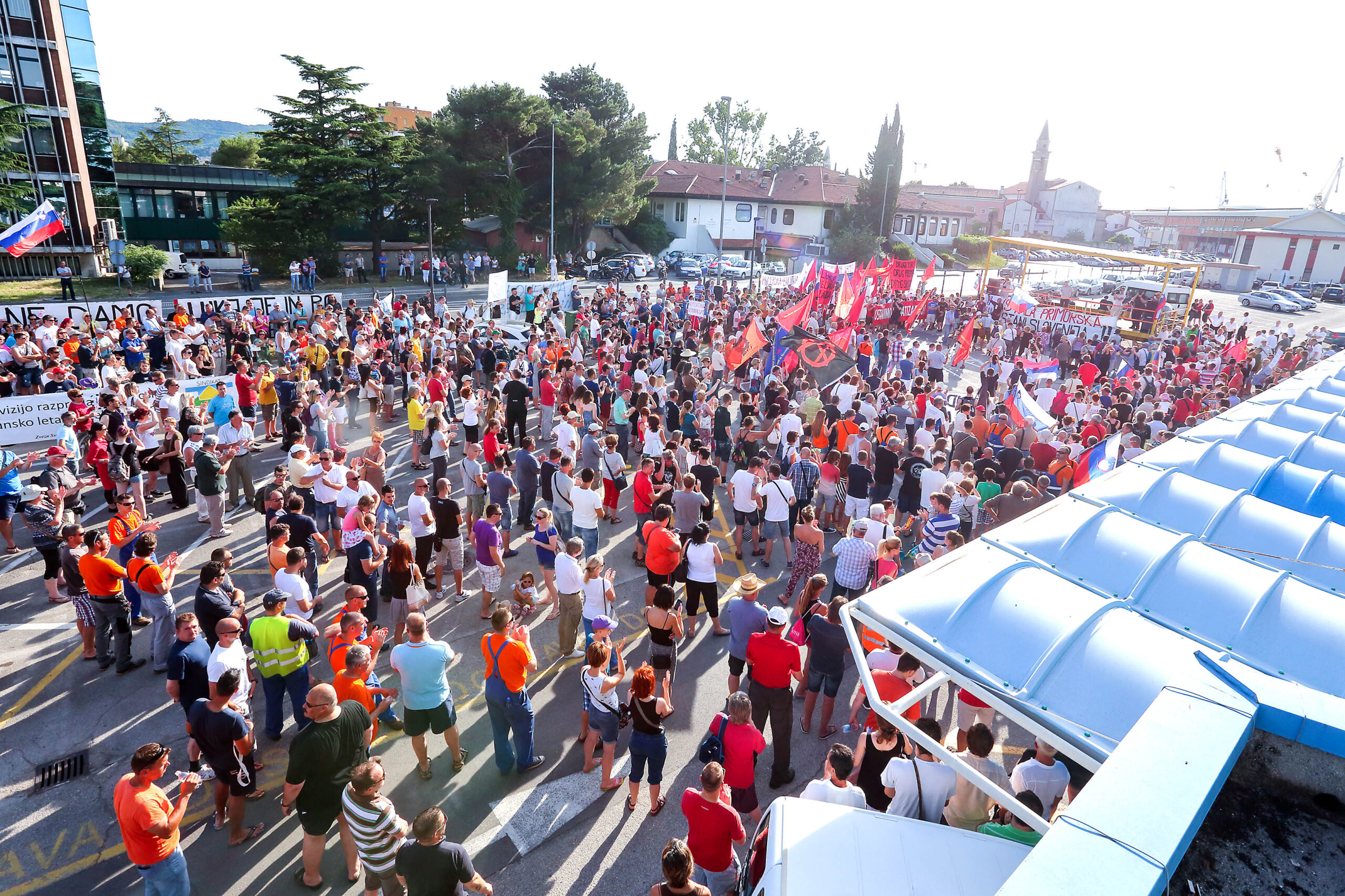
by ARNE ZUPANČIČ (Social Center Rog, Slovenia)
The Conflict Corner this week presents a text on the transformations of the port of Koper, the changes in its management and the crucial involvement of the workers organized by the Crane Worker’s Union to defend their interests against the neoliberal management that imposed itself since the ’80s. The article inserts the life of the Port and the workers struggles in the frame of the transformations that crossed Slovenia, its government, and of the crucial role of the logistical infrastructure and the heavy influences of foreign interests and investments. This analysis shows that the port of Koper is in Slovenia, while at the same time revealing the through and through transnational construction of nowadays national territories, as well as the fact the Europe is a space crisscrossed by corridors, infrastructures and flows that follow global logics. It shows, in turn, the necessity to organize on a transnational level. In the present situation the logistical strike cannot but be transnational and should be directed against several counterparts. The management of the port and the different private and public interests involved are often conflicting, but agree in finding the secret of neoliberal logistics in the increased exploitation of workers and their casualization. The key of this secret is to play out different wage levels and contractual conditions, not only among different spots of the global logistical chains, but also within the same port, challenging also the traditional union organizing based on sectors and professions. With this contribution we are willing to open up a wider discussion, as a follow up of the discussions held within the framework of the previous TSS meetings, about what does it take to oppose the logistics of capital on a transnational scale: what does it mean for a strike to be also logistical? How do we bring together struggles to disrupt flows with struggles in the working places? How do we connect across borders and conditions? These are the questions that lay in front of us.
When discussing the economic potential of Slovenia, there are three things that one would always mention: water, wood and position. Although we could discuss the raw materials in length as well, we will focus on the third part, which is the geostrategic position of Slovenia, its logistic infrastructure, and ways of managing it. The corner stones of the infrastructure are the railway system, a big part of which was inherited from the Austro-Hungarian times, and the Port of Koper, the youngest yet the fastest growing port in the northern Adriatic, which is becoming more and more recognized and important in Europe. In 2007, the Crane Workers’ Union in the Maritime Sector was established there. This union represents one of the rare examples of the well-focused and mature union struggle in Slovenia, and most probably in its surroundings as well. Unfortunately, as we already imply above, Slovenia’s only port and the crane workers’ union with it are both prisoners of a post-colonial reality. This means that despite the thoughtful and responsible work they do, it is possible that they will be forced to watch how the home infrastructure is being completely subordinated to foreign influences.
The History of the Port of Koper
The story of the Port of Koper was an example of workers fighting against the State already in the Yugoslavia. The port, although quite big and important today, only started to operate in 1957, after the City of Trst/Trieste together with its surroundings and the port were unjustly given to Italy. The power structures in Belgrade were fonder of promoting the port of Rijeka rather than building a new one in Koper. Nonetheless, the local cooperatives of fishermen and port workers from Izola and Koper decided to start constructing the first pier, and a year later the first trans-ocean ship was moored, and in ’67 the company paid almost all the costs of the construction of around 37-kilometer-long railroad between the port and the inland, connecting it to the old Austro-Hungarian infrastructure system. Actually, close to 90% of all investments in the port and its logistical network was made by the company itself, being owned by workers and ex-employees until the beginning of the ’90s. After the collapse of Yugoslavia and after gaining the national independency, Slovenia started to nationalize what was communally owned before, which was basically a theft of the workers, who were investing parts of their salaries and profits of the companies into further development and growth throughout the decades.
However, Koper managed to retain one peculiarity – the way of managing the port. The state company is both the owner and the manager of the port, a peculiarity that enabled the port to overcome the economic crisis of the years 2008 and 2009 very fast. Although quite a number of Slovene governments have expressed their wish to divide the ownership from the management, seven Italian ports introduced a similar system in the last few years, since this kind of a model has a greater resiliency and profitability, which the union also agrees with. Elsewhere, either the country or the municipality is the owner of the land and Port Authority, while the concessionaires who are carrying out the service are merely renting the land plots. The crane workers say that Koper’s type of managing is much better, since the port can function as a whole, and has bigger chances to fight off the negative financial operating.
The company has been run from the ’80s to 2004 by the same director, who managed the company in a typical neoliberal way. The workers felt that, besides being expropriated, also in a stagnation of their wages, unpaid extra working hours and introducing precarious forms of work instead of regular employments. After 2004, when the right-wing government took over in Slovenia for the first time, regular changes of management boards have started taking place and up until today there were seven of those already. Each of these boards fell because of the broken power relations between the union and the local, state, as well as European, and most importantly German and Austrian interests.
On a local level, the port is one of the biggest employers and around 7000 job positions are indirectly dependent on it. Besides that, the port finances the local football club and invests in the surroundings in two ways; in developing its own hinterland warehouses and other capacities, and as a donator for the development of the local area – each of these financial divisions of course being the result of various interests. The division and the using of the state concessions for the port in the Koper municipality led to the seceding of the Ankaran local community that created their own municipality. A few years ago a local member of the parliament was also found guilty of threats and bribing while dealing with land for the hinterland warehouses.
On the state level, the politicians are blocking the development of the port in several ways. For example, the ownership proportions of the parcels on which the Port of Koper stands are still not regulated. There were also troubles with gaining permissions for deepening the port, the preparation of the national spatial plan, in which the further area development of the port was being delayed. The highway junction has not been finished yet as well, which means that there are everyday traffic jams in the town of Koper.
However, all the issues mentioned above may seem trifle matters in comparison with the main one – the building of the 31-kilometre-long second track of the railway lineconnecting Koper to Divača that is imperative for the development of the port. The question why the current trail (built by the port itself in 1967) is not being modernized has not received a proper answer in the past 20 years, but it seems that it has something to do with the pressure of the foreign politicians and capital, which have been strengthening their own positions by hindering its construction. The existing track is 80% occupied and cannot transport all of the cargo in rush hours. Even Mercedes-Benz that started cooperating with the Port of Koper is warning of this narrow throat that causes great delays, however it is not the port that is responsible for that – the ones to blame are the state and the Slovene Railways.
The Slovene Railways, still state-owned, are the most horrible example of a bureaucratic dinosaur, the only thing changed with it in the last 30 years being that the control over the management and the unions in the company was taken from the communist partyand seized by the right-wing SDS party. The problem is of course not only ideological, since the railways are currently the laughing stock of the whole country due to its delays, out-of-date infrastructure, and mostly due to the lack of any kind of vision regarding its development. At the same time they are being ousted by the subsidiary company of the Austrian Railways. The Port of Koper may be the biggest port for Austria, but Austria is also the biggest partner of the port, with their cooperation only growing in the last years.
Apart from the Austrians, German logistical companies are present not only in Slovenia, but over the whole Balkan region, starting with the Deutsche Bahn and its subsidiary companies. The influence of the later was seen at the end of 2010, when Hartmut Mehdorn, the former first man of the Deutsche Bahn visited Slovenia at the invitation of Borut Pahor, our current president, but PM at the time. Mehdorn suggested Slovenia should unite the railways, the port and the biggest home forwarding agent Interevropa into a Slovene logistic holding. The plan was later dropped; partially due to the Crane Workers’ Union warning that what lies in the background of this plan is the wish for a later purchase of this holding by the Germans, as well as due to Mehdorn’s demand for a 476.000 euro fee for his counselling without a signed contract.
The Slovene Railways are still drowning financially and Interevropa is working on 10% of its former business and number of employees, while the Port of Koper annotates record-breaking results every year – results that have a positive influence both on the local economy, as well as on the state budget. Despite that, the aspirations for the privatization are extremely strong, and the politicians are backing these up with utmost inconsistent slogans. A similar example was Ljubljana airport, the sale of which was explained by European directives about the withdrawal of countries out of the ownership of the infrastructure; however, the airport was later on sold to the German company Fraport, owned mostly by the Hesse federal state and the Frankfurt city fund.
China, China, China, China!
One of the historically most important logistical projects currently taking place in the world is the new Chinese Silk Road, better known as OBOR (One Belt One Road) with its maritime part called the Maritime Silk Road, which is ought to connect China with the rest of the world by land and by sea. Although the Chinese were also competing for building the second track for the Port of Koper and were prepared to do it for one half less of the costs estimated by the Ministry for Infrastructure (in the meantime, they were also applying for purchasing Ljubljana airport), Slovenia chose the position of the southern of German countries instead of economic development. China therefore lays its hopes on the Greek Pireus that they bought last August. Furthermore, China is also the investor of the modernization of the railway line between Belgrade and Budapest (the investment is currently being examined by the European Union). The Port of Koper wants to be a part of this Maritime Silk Road as well and even joined the North Adriatic Ports Association (NAPA) in order to achieve that. That the ports of the NAPA could actually be able to take over a part of the business from Pireus, especially with the current Balkan political situation lately becoming more tense, was shown during the blockade of the railway line between Greece and Macedonia at the border crossing of Eidomeni – Gevgelija, when the HP concern temporarily used the Port of Koper in order to avoid the much more expensive land route through Bulgaria. The Crane Workers’ Union remains skeptical about it, claiming that a serious association which could operate in far-east markets would first have to overcome the illusion of the mutual competition between the north-Atlantic ports. For the time being, they see the NAPA as more or less a formal association with a strong but still unused potential.
The Union
The Crane Workers’ Union was established in 2007 as a response to three unions already existing which were either inoperative or functioned according to the instructions of the management. As told by the founding members, the working conditions were bad in the time, partially also because most of the workers are migrants who did not understand the contracts which they were signing, and did not differentiate between the brutto and netto wages. The logic behind the new union was simple; when the crane workers stop working, the whole port stops. This is the single parole that enrolled around 100 out of 140 crane workers in the first 24 hours of its existence. Later on, the union was joined in bigger numbers by the security workers and the railway workers of the port – the three most efficient professions to stop the work of the port.
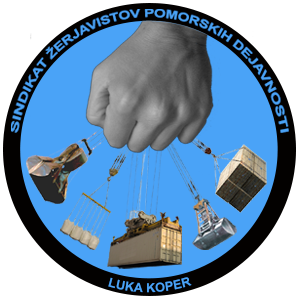
There was little knowledge at the beginning about the way the port and management board are operating, about the foreign politicians and companies influencing the decisions, as well as about geopolitical dimensions of the work they do. It was all developing slowly, first with the organisation of the port itself and the right of the workers for self-management and participation in the management board.Fortunately, there was a local lawyer specialized for labour lawhelping them at the beginning. It was only a year since the Union started to work and they already opened the collective contract for work conditions that is still valid today. During the negotiations, they have managed to raise the basic salaries for around 30% in two years, some professions were moved to higher pay grades, and there was instant salary reconciliation.
In the 2009 elections for the workers’ council, the union won resulting in two of their representatives joining the supervisory board. And although it was the first time for them to be involved on this level of workers’ participation, they were fighting hard, changed their representatives, and learned all the legal procedures with all the delicate manoeuvres that “most of supervisors do not experience in all of their careers”. At the end they managed to form a majority in the supervisory board and changed the whole management board that was drainingthe company at the time.
New battles came at the end of 2010 and were going on for over nine months. There were new negotiations about workers’ employment status, the management board was pushing towards precarisation and they stopped hiring new workers, despite the fact that the financial and trans-shipment were record-high every year. At the end of the negotiations, the union started a strike in July 2011 that went on for 8 days and at last the Ministry of Infrastructure and the management board signed all the demands of the workers. Since then, the Port of Koper employs 40-60 new workers every year.
The strike was important for different reasons as well – there were activists from all over Slovenia coming to show their support for the workers in the port and that opened new connections for union activists who started travelling around the country more, explaining their experiences, and supporting others in strikes and demonstrations. One of the examples of this kind of solidarity was the ousting of the mayor of Maribor, the second largest city in Slovenia, located some 250 kilometres away from Koper. In the final press statement the mayor made when leaving the office, he said that “he thinks it is not right that the people from Koper are removing him”. With this kind of actions, the Crane Workers’ Union gained trust and admiration among Slovenes, and hasset a new example of Union organizing.
The union with approximately 400 members (200 of them are crane workers) is also showing support for the refugee community, the self-organised squats around Slovenia, and the union members are constant guests at different conferences and workshops in the region. The most important part of their activities is the global perspective they are spreading. There is almost zero talk about geopolitics in Slovenia and the union, through their everyday work, through their international visits and international connections– mostly within IDC (International Dockworker’s Council)–is capable to explain how the world operates outside the subalpine suburban realms of Slovenia. Unfortunately, this is not the case for their home Union Association in Slovenia, the SZS Alternativa, where the majority is on the side of the Railways’ unions, most notably the Engine Drivers’ Union, which is taking the exact opposite stand to the one of the crane workers. According to the crane workers themselves, they often find themselves in weird situations, especially after last year’s spontaneous workers’ strike, when the question of the second track between Divača and Koper became the hot topic once again.
As already mentioned above, the Port of Koper is already often facing troubles with discharging ships, since the existent track towards hinterland is often overloaded, meaning that trans-shipping often gets delayed. The workers of the port have been drawing attention to the problem for quite a while now, yet none of the governments responded yet. With the new government coming to the parliament in the second half of 2014, the dynamics around the Port of Koper gained momentum once again. The week around the blockade in the summer of 2016 was filled with the home media trying to discredit the striking workers, some journalists even comparing them to an organized gang and occupiers, while the PM MiroCerar even stated that he does not intend to discuss the fate of the company with its workers. All this time, the media kept ignoring the president of the supervisory board who was being threatened that she should remove the management board, they ignored the minister of the infrastructure who coughed and evaded questions during interviews, as well as the prime minister who denied the workers their constitutional right of taking part in the decision making. Yet the long campaign of the union members on field, their articulated opinions, but above all the fact that they are not only dependent on this port for one mandate, but for life, brought the government to the point of withdrawing from their plans of management changes. Still, we are not even a meter closer to the construction of the much needed second track.
Besides the mentioned railway problem, the union is also dealing with one of the biggest inner injustice – the so called IPS (port service providers). There are still around 500 of them in the port and all of them are non-employed but only called when needed by the owners of various companies who have a contract regarding certain work signed with the Port of Koper. It is a super-precarious form of work, since the workers are actually self-employed and beside that, they often do not get to know their working schedules not even a day ahead. Despite the astronomical profits gained by the owners of the transmittal companies, the unions were so far not able to root out this kind of exploitation in the port.
Things are looking brighter though. Last year’s plan of the Crane Workers’ Union was to establish a workers’ cooperative, which would not gain astronomical percentage of the workers’ wages as the private transmittal companies do, but would be workers-friendly and able to compete with the other companies with lower service prices. This idea has not been realized yet, but the work conditions have improved for these precarious workers and more supervision over the transmittal companies was introduced. The current management showed desire to employ a part of these workers, but not all of them, since that could bring about a profit shock. The union is sticking with the motto of equal payment for equal work, so their fight inside the port will continue.
Conclusion
The Port of Koper confirmed in a recently published report that it is once again achieving great results; it is the biggest container transshipment in the Adriatic, it is the third biggest port for cars transport in the Mediterranean, its growth is consistent and sustainable, and the workers are, especially comparing to the other ports around the world, taken better care of. All the same, the problem of the unions is that they need a functioning company in order to exist. The Crane Workers’ Union has proved in the past ten years that it can fight for their workers’ rights as well as take care of keeping the public informed about the happenings in the company, thus making sure that the state cannot do what it wishes with the property that was stolen from the workers. Not on its own, and not according to the dictates coming from Brussels or Berlin. At the same time, they also made it clear that any management that will not work in accordance to workers’ interests will be sacked and replaced with a management that is capable of looking further than only towards the end of their own mandates.
Translated by Petra Meterc
